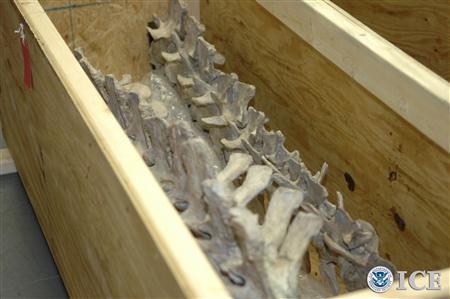By Joseph O’Leary
NEW YORK (Reuters) – U.S. officials on Friday seized the skeleton of a Tyrannosaurus dinosaur that Mongolia wants returned on suspicion that it was smuggled to the United States from the Gobi desert.

The bones of the tyrannosaurus bataar, an eight-foot-tall, 24-foot-long cousin of the Tyrannosaurus rex, were taken in a moving van from the Cadogan Tate Fine Art storage company in Queens, where they had been stored in four large wooden crates.
The President of Mongolia, Elbegdorj Tsakhia, demanded that the skeleton be returned to his country after it was auctioned on May 20 for $1.05 million (673,600 pounds) by Dallas-based Heritage Auctions.
The buyer of the skeleton was never disclosed. But the man who acquired the skeleton and offered it to Heritage for auction, said he has been unfairly labeled as a smuggler.
“I’m just a guy in Gainesville, Florida trying to support my family, not some international bone smuggler,” commercial paleontologist Eric Prokopi said in a statement.
“It’s been claimed that I misrepresented what was being imported and did not properly declare its value. I can wholeheartedly say the import documents are not fraudulent,” Prokopi said in the statement issued through Heritage.
A U.S. government lawsuit filed on Tuesday on behalf of Mongolia said the customs forms filed when the skeleton was imported incorrectly stated the country of origin was Great Britain, its value was $15,000 instead of $1 million it sold for, and mentioned only reptiles not dinosaurs.
Prokopi did not say in his statement where or from whom he acquired the skeleton. He said that when he received the tyrannosaurus bataar, it was a collection of loose, mostly broken bones and rocks with embedded bones. Prokopi said he and his wife spent thousands of hours preparing and mounting the skeleton, which increased its value, before it was auctioned.
On Monday, U.S. Attorney Preet Bharara filed a lawsuit seeking the forfeiture of the skeleton to the Mongolian government. An order to seize the fossil was issued on Tuesday.
Robert Painter, the lawyer representing Mongolia, said that the dinosaur will be held by the U.S. government while legal proceedings on its future continue.
Anyone who comes forward to claim ownership of the skeleton will have to prove they are the rightful owner or the U.S. will repatriate the skeleton to Mongolia.
“Today we send a message to looters all over the world: We will not turn a blind eye to the marketplace of looted fossils,” Mongolian President Tsakhia said in a statement.
The skeleton was discovered in 1946 during a joint Soviet-Mongolian expedition to the Gobi Desert, Bharara said.
Heritage Auctions and the Mongolian government agreed in May to jointly investigate the ownership of the skeleton. Several paleontologists examined the bones and determined they were removed from the western Gobi Desert between 1995 and 2005.
(Reporting by Joseph O’Leary; Additional reporting by Marice Richter in Dallas; Editing by Greg McCune and Anthony Boadle)





